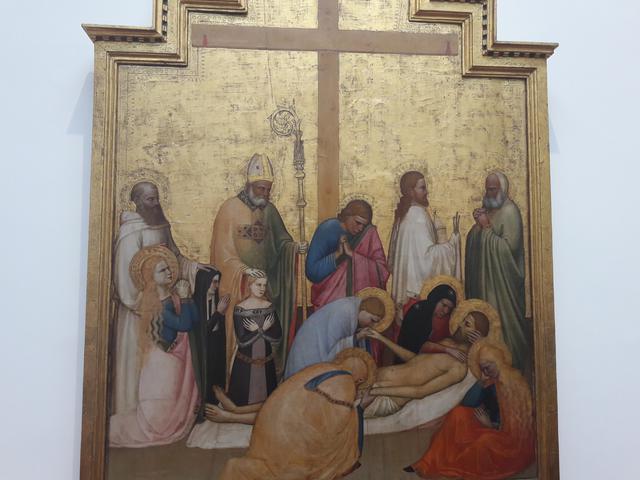Pieta di San Remigio

The Pieta di San Remigio is a work by Giottino dating from around 1360-1365. Since the time of Giorgio Vasari (Le Vite, 1550) it is considered one of the best works of Florentine painting of the second half of the 14th century.
The altarpiece was in the altar or partition of the church of San Remigio in Florence. In 1851 it was transferred to the Uffizi, where it has always remained, apart from the parenthesis of 1940-1945 when it was transferred as a precaution to the war shelters of the village of Poggio a Caiano and the Castle of Poppi.
Vasari saw it and mistakenly attributed it to Maso di Banco. An important contribution to the clarification between Maso, Giottino and his father Stefano Fiorentino belongs to Roberto Longhi, who noted the "Nordic" character of Giottino's painting.
The work takes up the scheme of Giotto's Lamentation of the Dead Christ in the Scrovegni Chapel (the position of Christ and some characters is reflected), updated to a new and intense expressive pain of the characters. On a dazzling gold background on a red preparation, which cancels out the space but exalts the spiritual sense of the scene, we find the Cross of Christ with the YNRI cartouche, which occupies the entire upper part and the cusp. In the center and at the bottom are the figures gathered around the dead Christ, each with a different emotional reaction quickly investigated: the expressive tears of the Magdalene, the dismay of Saint John with his hands together, the concern of the character standing on the right.
Thus, the characters recover the humanity of their feelings, anticipating the future developments of humanism, which restored the value of the individual. As in Giotto, the figures are arranged on several levels, avoiding schematism and maintaining a three-dimensionality, which in this case does not reach the master's results, also due to the abstract gold background.
The presence of the clients within the scene is not published on the left: the young woman and the kneeling nun who receive protection (effectively represented by the hand on her head) by Saint Remigius, patron of the church, and Saint Benedict, patron of The Benedictines. that surely it had to belong to the religious; They attend the scene with attention and silent participation. The figure of the woman is painted with extreme attention to detail, dressed in a rich black dress, adorned with an embroidered border at the neckline and tightened by a belt of enamelled plates, which falls gently over her hips. In this meticulous care, Giottino moves away from the compact and synthetic masses of the master's painting, rather towards what would be the developments of international Gothic: perhaps this is due to a Lombard influence.
The technique used is based on delicately shaded colors and clear light, reminiscent of the style of Maso di Banco in the contemporary frescoes of Vernio's Bardi Chapel in Santa Croce.
© Tourblink